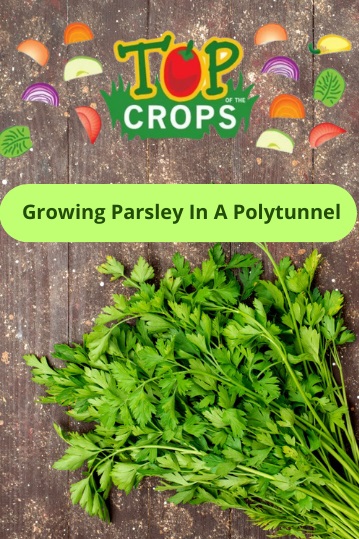Parsley, Petrosilenum crispum, is one of the staples of many herb gardens in the UK and can be an abundant and productive herb.
In a polytunnel, parsley grown well and in the right conditions can thrive all year round. This versatile herb can be used in a wide range of different recipes and an be an extremely useful addition to a polytunnel kitchen garden.
Parsley can be remarkably tolerant of quite a wide range of conditions. It can grow in full sun or partial shade quite happily. It will do best in a soil that is reasonably fertile, and moist yet free draining, but is relatively unfussy about soil type or pH as long as waterlogging does not occur.
This is a herb that will do well towards the base of a herb spiral, and will not mind some shade – partial or dappled, as long as it is not in deep shade.
A herb spiral is one interesting type of growing area for growing herbs that polytunnel gardeners might consider. Of course, parsley can also enjoy the conditions in a range of other types of growing area.
Parsley can be grown in the ground or in raised beds around or between other crops. It can also be grown in a different dedicated herb garden alongside other herbs that like moist yet free-draining growing conditions. And it can also thrive in pots so can also be suitable for a windowsill, or a container garden elsewhere.
| Jan | Feb | Mar | Apr | May | Jun | Jul | Aug | Sep | Oct | Nov | Dec | |
| Sow |  |
 |
 |
 |
 |
|||||||
| Plant |  |
 |
 |
|||||||||
| Harvest |  |
 |
 |
 |
 |
Parsley is not difficult to grow, though patience is required to grow this herb from seed since it can be extremely slow to germinate and get started.
There are two types of parsley that are commonly used in cooking – flat leaf parsley and curly leaf parsley. Both can take up to a month to germinate, but once it has done so, two sowings a year can guarantee you a healthy supply of this fresh herb throughout the year.
Sow parsley between March and May and, if required, you can also sow a second batch for fresh, young leaves over winter in the early autumn.
You can either sow parsley into seed trays, small pots or soil blocks indoors early in spring, or direct sow the seeds where they are to grow outdoors in the ground, raised beds or containers after the last frost date where you live.
Sow shallowly and make sure to keep well watered, especially when the weather is warm and dry in the spring and summer. Ideal temperatures for germination are around 21 degrees, but parsley seeds will germinate as long as the temperatures are above 10 degrees C..
Warming the soil a little before planting may help to aid in germination if you are direct sowing, though patience will still be required as germination can often take some time. Do not give up too early.
Since parsley, like carrots and certain other seeds can be slow to germinate, it can be a good idea to sow them in rows with seeds that will sprout much more quickly – like radishes. Radishes will mark your rows and will be harvested before the parsley really needs the space.
Aim to sow seeds around 15-20cm apart, or a little further apart for larger plants.
Seedlings of indoors sown parsley should be hardened off once they are around 15cm in height and placed out into their final growing positions in the polytunnel or elsewhere in your garden once the area becomes frost-free.
If, rather than growing parsley from seed, you purchased a plant, this can be planted into a pot indoors for a windowsill plant at any time, placed into your polytunnel or other garden areas any time when it is frost-free, though spring or autumn planting is generally best.
Note that the taproot of parsley is fragile and so you need to take extra special care if you are transplanting not to do any damage to the roots.
Parsley is not a challenging crop to grow at all. As long as its basic environmental needs are met, you will find that it does not need a lot of your care or attention once established in your garden.
The main job when growing parsley will be making sure it gets enough water if you are growing undercover.
Outdoors, natural rainfall will often be sufficient but in a polytunnel, of course, you are taking watering into your own hands. Make sure that you keep the soil or growing medium moist and yet also make sure that excess water can drain away reasonably freely.
After parsley emerges from the ground or you have planted your parsley, it is a good idea to mulch around but not touching the base of your plants. Mulch – such as a good quality homemade compost or well-rotted manure, helps protect and improve the soil while also conserving soil moisture and suppressing weed growth to a degree.
As with most leafy plants, parsley will also benefit from a good quality nitrogen rich organic feed, though once growing, parsley is extremely low maintenance and will not need a lot of looking after.
One important thing to understand about parsley when growing it is that this is a biennial plant, which, if left to its natural lifecycle, will grow foliage one year and then bloom and die back the next.
When the flower stalks form, it is important to remove these so that you can continue to harvest the foliage of your plants.
You may also wish to snip off any older, lower leaves that turn yellow early as this will also help to encourage new growth.
Many gardeners will grow parsley as an annual and will not bother to keep it until the second year of its growth.
But remember that while the plant will no longer be harvestable once it flowers, the flowers are beneficial for garden wildlife and if you allow the parsley to set seed you can either collect those seeds to sow or allow the plant to self-seed naturally.
When you wish to harvest your parsley, take single leaves as required or cut bunches low down on the stems with a pair of scissors. Remember that you can use parsley stems as well as the leaves.
Parsley is best used fresh but can also be dried or frozen for use later in the year if you are not growing an overwintering crop.
Varieties of parsley that you might grow include:
Flat leaved varieties such as:
French
Italian giant
Titan
These tend to be decorative, with a milder flavour.
And curly-leaved parsley varieties such as:
Bravour
Envy
Moss Curled
Curly-leaved parsley varieties tend to be stronger in flavour.
Parsley can experience problems when its environmental needs are not met, so it is first of all important to look to placement and care.
One other thing to remember when deciding where to place parsley, and also when looking out for pests and other problems is that parsley is related to carrots and celery and can experience a number of the same issues as these crops, such as carrot fly and celery leaf mining fly, to give just a couple of examples.
For this reason, it is typically best to avoid placing them too close to each other in your garden. Otherwise diseases and pests may spread between them.
When it comes to pests, among the most common are slugs and snails, from which you may need to protect your parsley, especially while the plants are still young.
The main reason that growing parsley in a polytunnel is a good idea is not actually for the benefit of the parsley itself, which will typically do fine outdoors in many areas.
Growing parsley in a polytunnel will typically ensure that it makes it through the winter months, but the main reason to place it undercover is as a companion to other key polytunnel crops.
Parsley may be a beneficial trap crop to attract pests that would otherwise prey on your tomato plants. It may also be a beneficial companion plant for peppers, pumpkins and a range of other plants due to the fact that it can encourage useful predatory insects to your polytunnel.
Hunt, T., (2023) How to turn parsley stalks into a powerhouse condiment. The Guardian. [online] available at: https://www.theguardian.com/food/2023/nov/04/parsley-stalks-powerhouse-condiment-zero-waste-cooking-tom-hunt
